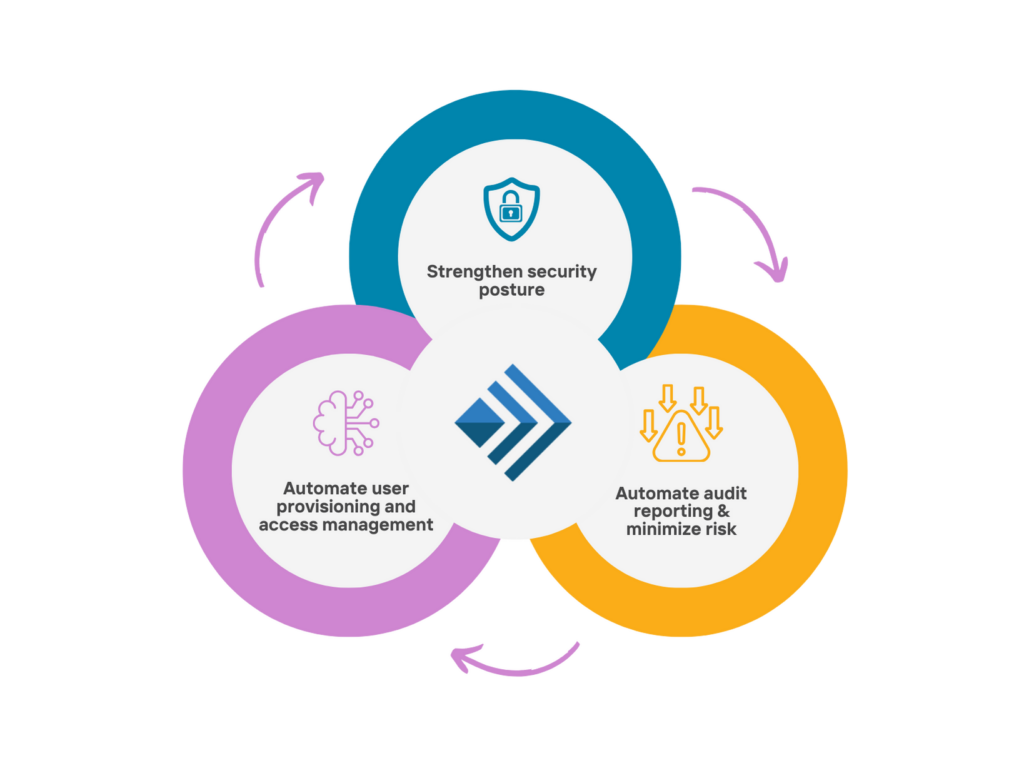
Identity and access management thrives on simplicity yet must constantly deal with complexity. The greater the number of identities, applications, and policies managed, the more inefficient and insecure it becomes. Insufficient identity credential and access management solutions compound with hefty manual data curation. This results in a ballooning challenge set to worsen over time. The fix is an IAM automation solution.
By selectively automating the parts of your identity fabric which do not require direct oversight, you free up time and resources in the long run. Furthermore, with the right policy planning performed by identity experts, you can automate even greater sections of your fabric. Read on and learn how IAM automation contributes to your optimal identity management solution and builds IAM maturity.
The Need for an IAM Automation Solution
Controlling the different pillars of IAM requires a considerable amount of work. Between onboarding new users, maintaining active identities, and curating unnecessary permissions, the workload quickly spirals out of control. This creates even bigger problems for middle managers and C-suite. After all, overwhelmed operations staff signal the emergence of security and compliance risks. Automation of repetitive yet crucial tasks forms the first step of mature identity workload management for the whole identity fabric.
Beyond saving time and funds on tedious tasks, automation forms a core part of effective cybersecurity. The rise of identity as the cornerstone of modern attack vectors (credential compromise, unsecured user identity stores, etc.) requires strict control over identities. Unfortunately, manually monitoring each identity and how it is being used is nearly impossible. Or, at least, impossible for a human workforce. When fine-tuned by identity experts and calibrated to an enterprise’s unique needs, automatic identity systems fill gaping holes in perimeters.
Insufficient automation results in unnecessarily wasted time. Employees spend weeks on tasks which might have taken a tenth or even 1% of the time. For example, Simeio previously cut down a client’s application onboarding time by 89%. The 2013 Target HVAC attack and 2023 MGM/Caesar’s breaches are prime examples of long-term consequences when IAM automation is not in place. An IAM automation solution, when integrated into the moment-to-moment operations of your enterprise, serves as your outer wall and your safety net. Automation provides you with the best chance of detecting issues before they arise and remediating them the second that they do.
What is the Potential of AI in IAM?
IAM automation solutions serve as a frontier of effective identity security and efficiency. As new superior techniques develop, the best enterprises stay on the lookout for potential game-changing trends. Few topics are as hot in the realm of technology trends as generative artificial intelligence. From debates over AI-generated art to the potential security risks of deepfakes, AI has garnered a reputation as a disruptive yet alluring development. However, now individuals are discussing how AI can solidify security and privacy instead of compromising it.
However, note that AI in IAM is not the same as automation in IAM. AI is generative, creating new processes based upon the data it is fed. Some processes such as AI-created content and predictive analytics have AI as their central pillar. However, only aspects of this technology are observed in adaptive MFA and continuous compliance monitoring. In both cases, criteria-based policy enforcement takes preeminence over true AI.
The potential for future developments will likely remain in the realm of speculation for the foreseeable future. At present, too many enterprises are still wrestling with the implementation of contemporary ideas like zero trust and identity orchestration. Companies must be careful when implementing AI as a core part of their identity fabric. The potential consequences of failure include opening up a wide vector for bad actors to traipse on through.
How your IAM Automation Solution Determines your IAM Maturity
Maturity is all about readiness. Simply put, without automation, you’re not ready. By having automatic detection systems in place, your systems are not bound by human capabilities. Furthermore, automation doesn’t end at just stopping threats in progress. It also can help avoid incidents altogether through automated IGA and PAM solutions.
A single vulnerability in a cybersecurity perimeter compromises the entire attack surface. But a mature identity system leverages meaningful IAM solutions to keep pace with evolving cyber threats. This is especially important when defending against things like third party vulnerabilities. Across such a broad attack area, your systems rely upon either a prohibitively huge workforce or an elegant automation system to stay competitive.
With a good policy backed by automation, your previously insufficient policy becomes effectively enforced. This isn’t just for important privileged powers. It also concerns the day-to-day management of permissions, removing hefty login burdens and keeping minds on business goals.
How Simeio Can Help Your IAM Automation
Platforms like a solid identity orchestrator can be your step towards designing and implementing your IAM automation solution. By starting with a meaningful identity benchmark, you can determine the scope needed for your system and build the automation from the ground up, fitting it to your potential needs without getting things you don’t need to pay for.
Schedule your IAM maturity assessment now and learn what optimal automation looks like in your enterprise.
